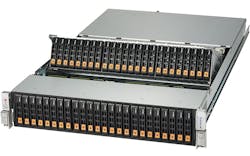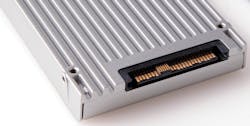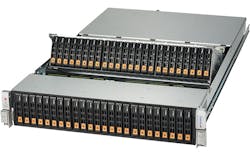This file type includes high-resolution graphics and schematics when applicable.
A monopoly could well be forming before our eyes in the storage arena, and it’s known as NAND flash memory. Storage form factors are changing, as are the interfaces involved with Non-Volatile Memory Express (NMVe)—all of it pushing the performance envelope even further.
A form-factor connector making a splash in this space is U.2 (Fig. 1), formally known as SFF-8639. Available on the 2.5-in Enterprise Form Factor, it actually supports up to four SAS/SATA interfaces and PCI Express x4, including dual port configurations. In addition, the connector provides power and an SMBus interface, plus it supports hot swapping. The U.2 PCI Express interface is on par with the M.2 PCI Express interface (see “What’s the Difference Between M.2 Modules?”).
There are two performance reasons for moving to PCI Express rather than SATA or SAS. The first is scalability: Multiple PCI Express lanes can be used to provide more throughput (for example, x1 and x4 M.2 devices are available). Second, PCI Express lowers overhead and latency, because no additional controllers are needed between the host and the drive.
A drive needn’t use all of the interfaces. A motherboard or controller can implement multiple interfaces, allowing it to support different types of drives. For example, a motherboard could support SATA, SAS, and PCIe/NVMe drives. Drives like Intel’s 750 Series typically implement a single interface. In this case, the PCI Express x4 interface provides support for NVMe.
Platforms like Super Micro Computer’s (SuperMicro) 2U SSG-2028R-NR48N (Fig. 2) and Dell’s 2U PowerEdge R820 (Fig. 3) provide support for NVMe solid-state drives (SSDs) as well as SATA and SATA drives. The PowerEdge R820 features 16 drive slots with up to four Intel E5-4600 processors plus 1.5 TB of DDR3 DRAM. Meanwhile, the SSG-2028R-NR48N packs in two banks of 2.5-in. hot-swap NVMe drives supported by a pair of Intel E5-2600 processors and up to 3 TB of DDR4 DRAM.
PCI Express adapter cards support this type of drive, but most applications will utilize PCI Express SSDs instead. For motherboards with M.2 sockets, ASRock offers a U.2 Kit that plugs into an M.2 socket with Mini-SAS connectors that are linked to a U.2 drive via a cable.
At this point, enterprise applications are pushing NVMe drive support. However, embedded applications such as data logging and video processing will begin to demand the performance and flexibility available with the U.2 form factor. Needless to say, the drive form factor provides a modular implementation that’s highly desirable.
Looking for parts? Go to SourceESB.
About the Author
William G. Wong
Senior Content Director - Electronic Design and Microwaves & RF
I am Editor of Electronic Design focusing on embedded, software, and systems. As Senior Content Director, I also manage Microwaves & RF and I work with a great team of editors to provide engineers, programmers, developers and technical managers with interesting and useful articles and videos on a regular basis. Check out our free newsletters to see the latest content.
You can send press releases for new products for possible coverage on the website. I am also interested in receiving contributed articles for publishing on our website. Use our template and send to me along with a signed release form.
Check out my blog, AltEmbedded on Electronic Design, as well as his latest articles on this site that are listed below.
You can visit my social media via these links:
- AltEmbedded on Electronic Design
- Bill Wong on Facebook
- @AltEmbedded on Twitter
- Bill Wong on LinkedIn
I earned a Bachelor of Electrical Engineering at the Georgia Institute of Technology and a Masters in Computer Science from Rutgers University. I still do a bit of programming using everything from C and C++ to Rust and Ada/SPARK. I do a bit of PHP programming for Drupal websites. I have posted a few Drupal modules.
I still get a hand on software and electronic hardware. Some of this can be found on our Kit Close-Up video series. You can also see me on many of our TechXchange Talk videos. I am interested in a range of projects from robotics to artificial intelligence.





